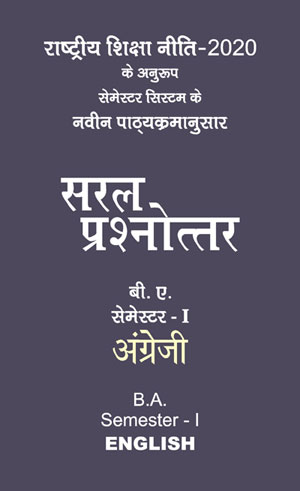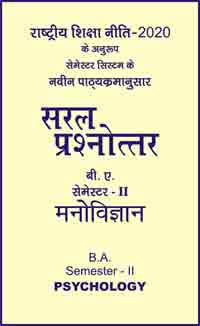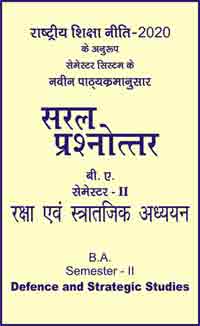|
बी ए - एम ए >> बीए सेमेस्टर-1 अंग्रेजी बीए सेमेस्टर-1 अंग्रेजीसरल प्रश्नोत्तर समूह
|
5 पाठक हैं |
|||||||
बीए सेमेस्टर-1 अंग्रेजी के प्रश्नोत्तर
Sarojini Naidu
Question- Write a detailed life-sketch of Sarojini Naidu. Also describe in her works and contribution towards Indian Writing English.
Ans-
Sarojini Naidu was born on 13 February 1879 in Hyderabad, India to the scientist, philosopher and a politieducator Aghornath Chattopadhyaya and Barada Sundari Devi. She was the eldest daughter of her parents. A political activist, her father was a co founder of the Nizam College and the first member of the India National Congress in Hyderabad. Chattopadhyaya was removed from his position as a penalty for his active participation in Indian Independence movement.
Virendranath Chattopadhyaya, Sarojini's brother, was a political activist who played a key role in establishing the Berlin Committee and was influenced by Communism. He was allegedly killed by the Russian troops in 1937. Sarojini's second brother Harindranath Chattopadhyaya was a noted poet and playwright. A brilliant student, Sarojini won appreciation and fame by being selected in Madras University at just 12. In 1895, she went on to study at King's College in London and later at Girton College, Cambridge University. She developed a liking and passion for reading and writing poems whilst still in college where she became proficient in many languages including Urdu, English, Persian, Telugu and Bengali. Whilst still in college, Sarojini met Dr. Muthyala Govindarajulu Naidu and both grew closer by the end of her college. Upon finishing her studied at age 19, she married him in 1898 during a period when inter-caste were marriages were rare and considered a crime in the Indian society. None the less, the successful marriage of the couple prevented people from inter vening into their personal life and taking it on to another stage. The couple had four children; Jayasurya, Padmaja, Randheer and Leelamani. Her daughter Padmaja followed into her footprints and became the Governor of West Bengal. In 1961, she published a collection of poems entitled The Feather of The Dawn. Sarojini Naidu had many credits to her, including a notable contribution to the Indian Independence Movement. She joined the movement at the rear of Bengal partition in 1905 and since then, she stuck to her commitment to the cause. While working for the Indian National Congress, she was introduced to many eminent personalities such as Muhammad Ali Jinnah, Jawaharlal Nehru and Mahatma Gandhi with whom she shared as pecial bond and a very good rapport. During 1915-1918, she traveled across the India lecturing on social welfare, women empowerment, emancipation and nationalism. Inspired by Jawaharlal Nehru, she embarked on providing help and support for the indigo workers in Champaran who were being subjected to violence and oppression. In 1925, Naidu was appointed the President of the National Congress thus making her the first Indian women to hold the post. With the introduction of the Rowlett Act in 1919, Sarojini joined the Non-Cooperation Movement organized and led by Mahatma Gandhi. In the same year, she was appointed the Home Rule League's ambassador to England. In 1924, she became a delegate to the East African Indian Congress.
In her last years, Sarojini actively participated in the freedom movement and was a part of the Round Table summit held in 1931. In 1942, she was arrested along with Mahatma Gandhi for her involvement in the Quit India movement and was jailed for almost 2 years. After her release from the jail, she presided over the Steering Committee at the Asian Relations Conference. With the independence of India in 1947, Sarojini Naidu was made the Governor of the Uttar Pradesh in the wake of her contribution to the movement. She was the first woman to become the governor of a state. She died of a heart attack while working in her office on 2 March 1949.
Contribution of Sarojini Naidu Towards the Growth of Indian Writing in English
Beside her role and contribution to the Indian Nationalist Movement, Sarojini Naidu is also revered for her contribution in the field of Indian poetry. Many of her works were transformed into songs. She drew her inspiration from nature as well as surrounding daily life and her poetry echoed with the ethos of her patriotism. In 1905, her collection of poems was published under the title "Golden Thres hold". Later, she also published two other collections called "The Bird of Time", and "The Broken Wings", both of which attracted huge readership in both India and England. A part from poetry, she also penned articles and essays like 'Words of Freedom' on her political beliefs and social issues like women empowerment. The Nightingale of India, Sarojini Naidu was a prolific writer and poet. The first volume of her poetries The Golden Threshold was published in 1905, after which two more collections The Bird of Time and The Broken Wing arrived in 1912 and 1917 respectively. Mean while in 1916, she authored and published a biography of Muhammad Ali Jinnah entitled as The Ambassador of Hindu-Muslim Unity. Other acclaimed poems that came following are The Wizard Mask and A Treasury of Poems. Other selected works written by her include The Magic Tree and The Gift of India. She was given the name Bharat Kokila on account of the beautiful and rhythmic words of her poems that could be sung as well
Sarojini Naidu Works
In 1905, The Golden Threshold was published as the first volume of her book of poems. There were two additional volumes published: The Bird of Time (1912) and The Broken Wingin (1917), which also included "The Gift of India'. In 1919, she published the autobiography of Muhammad Jinnah and in 1943, The Sceptred Flute: Songs of India along with Allahabad: Kitabistan was posthumously published. In the year 1961, she published "The Feather of the Dawn' which was edited by her daughter Padmaja Naidu. The Indian Weavers' was published in 1971. Her poetry had beautiful words which could be sung as well which led to her being called the nightingale of India.
|
|||||
- Question- Discuss Sri Aurobindo's contribution to Indo-Anglian poetry.
- Question- Discuss Sri Aurobindo as a mystic poet.
- Question- "Tagore is a lyric poet par excellence." Comment.
- Question- "Tagore is not a poet of Bengal, but of India and the world." Discuss.
- Question- Write a note on life and works of K. S. Venkataramani.
- Question- Describe Venkataramani's reflection on village life which he presented in his novels.
- Question- Write the life and writing style of Bhabani Bhattacharya.
- Question- Write about Bhattacharya's concept of Fiction.
- Question- Consider R. K. Narayan as a novelist.
- Question- Describe Indianess in R. K. Narayan's novels.
- Question- Write a note on Mulk Raj Anand's place in English Literature.
- Question- Write a note on the main influences on Mulk Raj Anand.
- Question- What is Mulk Raj Anand's contribution to the development of Indo-Anglian fiction?
- Question- What are the general themes of the novels of Mulk Raj Anand?
- Question- Write a short note on Mulk Raj Anand as a social critic of downtrodden society.
- Question- What is the contribution of Mulk Raj Anand to Indian English Literature?
- Question- Write a detailed life-sketch of Sarojini Naidu. Also describe in her works and contribution towards Indian Writing English.
- Question- Write life and career details of Kamala Markandaya in detail.
- Question- Write a note on the contribution of Kamala Markandaya towards the growth of Indian English Literature.
- Question- Write a comment on Kamala's 'Art of Narration".
- Question- Write a note on life and works of Nayantara Sahgal.
- Question- Write a list of the works of Nantara Sahgal?
- Question- Which is the last novel of Nayantara Sahgal?
- Question- Explain Plot in a Short Story.
- Question- What is characterization in a short story? Discuss the types & importance of characterization.
- Question- What is the meaning of Narrative Techniques? Explain types of narrative technique with examples.
- Question- Write a note on the Narrative structure and its types. Discuss in brief.
- Question- What is prose and what types of prose are found in English Literature?
- Question- What is short story?
- Question- What is an essay?
- Question- Discuss novel.
- Question- What is autobiography?
- Question- What is biography?
- Question- What is play?
- Question- What is Travelogue ? Mention two books that belong to this class of literature.
- Question- Discuss Pamphlet.
- Question- What is biography? Name two famous biographies in English.
- Question- What is an informal essay? Who is a well-known informal essayist of English Literature?
- Question- Distinguish between formal and personal essay. Give examples.
- Question- How would you distinguish between early eighteenth century and early nineteenth century style in literary essay writing?
- Question- What is an autobiography? How is it different from a biography?
- Question- What is theme? Explain in detail.
- Question- What do you know about Sentence Pattern?
- Question- What do you know about Imagery and Explain the types of Imagery?
- Question- What is Tone or Mood? Elaborate it in detail.
- Question- What is the definition of 'Point of View' ?
- Question- What do you understand by Humour ? Also write the characteristics and kinds of it.
- Question- What is the meaning of Analogy?
- Question- What do you mean by Anecdotes?
- Question- What do you mean by Aphorism?
- Question- What are the definitions of Inversion?
- Question- How do you define a theme?
- Question- What is the theme in a story?
- Question- What are the main themes?
- Question- What is imagery and its example?
- Question- Define Pathos in literature.
- Question- What are the origins of Pathos ?
- Question- What is Pathos?
- Question- What are the models of humour?
- Question- What do you mean by Antithesis?
- Question- What do you mean by diction?
- Question- O. Henry's The Last Leaf is the story of perseverance. Discuss.
- Question- Describe the character of Sue in the story 'The Last Leaf.
- Question- How does Johnsy deals with her illness?
- Question- Explain the theme and the title of the story "The Last Leaf."
- Question- Attempt a detailed character sketch of Iona.
- Question- Comment on the setting, theme and tone of the story.
- Question- What message does the story 'Lament' provide?
- Question- Analyse the story with reference to its relevance in the present context.
- Question- Comment on the symbolism in the short story "The Lament'.
- Question- Who is Iona ? What impression of his character do you get from the story?
- Question- Why is it important for Iona to be able to tell someone about his son's death?
- Question- Comment on the indifference that meets Iona's attempts to share his grief with his fellow human beings.
- Question- How does the horse serve as a true friend and companion to Iona ?
- Question- Empathy and understanding are going out of modern society. The individual experiences intense alienation from the society around him or her. Comment.
- Question- Explain in detail the life and work of Guy de Maupassant.
- Question- What is the summary of the story The Terror' by Guy de Maupassant?
- Question- What is the theme of the story The Terror' and describe it in your own words?
- Question- Write the Introduction of the story The Terror'.
- Question- What is the point of view in this story "The Terror' by Maupassant?
- Question- What is meaning of 'Fear' and 'Sense' in this story The Terror?
- Question- What is in Mental Disorder in this story The Terror'?
- Question- The writer presents his attitude towards women in this story "The Terror'. Explain it.
- Question- What is the summary of the story The Barber's Trade Union' by M. R. Anand.
- Question- Who is the Protagonist of the stoey The Barber's Trade Union"?
- Question- Why was Chandu not good at doing sums at school?
- Question- Why did the narrator's mother constantly dissuade him to play with Chandu?
- Question- What is the meaning of Trade Union?
- Question- What is the summary at the story 'Under The Banyan Tree' by R. K. Narayan?
- Question- Describe the village Somal.
- Question- Who is Nambi in the story 'Under the Banyan Tree' ?
- Question- What do you understand by 'enchanter"? Why does the author call Nambi an 'enchanter"?
- Question- What is irony? How does Narayan use it in this story?
- Question- "It was story building on an epic scale." What do you understand by this statement? Elaborate.
- Question- Why does Nambi says, "...... Age, age. What is my age? it has come on suddenly ?"
- Question- Describe Nambi's life after he stops telling stories? Do the villagers reject him?
- Question- Explain "terrible sense of his insignificance" which Ravi feels at the end of the story. What lesson has he learned about life?
- Question- Discuss the various themes in the story.
- Question- Comment on the plot of the story.
- Question- Attempt a detailed character sketch of Ravi.
- Question- What do you know about the setting of the story, 'Games At Twilight'?
- Question- Who is Raghu ? What do you assess about his character?
- Question- Describe the garden in which the children are playing hide and seek.
- Question- What are your impressions of the following children from the first section of the story?
- Question- How is the shed described? Why are these details important to understanding Ravi's feelings?
- Question- How did Ravi lose without being caught?
- Question- Analyse the theme of Bacon's eassy 'Of Studies.'
- Question- Write an essay on Bancon's prose style.
- Question- Critically appreciate Bacon's 'Of Studies'.
- Question- What message does Bacon try to put across in the essay 'Of Studies'?
- Question- The essays of Bacon are concerned only with worldly wisdom and the art of success. Discuss.
- Question- What type of books are recommended by Bacon for studies?
- Question- What are the bad effects of studies according to Bacon?
- Question- How does Bacon justify that various defects of mind can be cured by particular studies?
- Question- Who is the author of 'Of Studies'?
- Question- According to Bacon what is the use of studies?
- Question- How studies are used by different kinds of people?
- Question- Bacon says 'Studies pass into character', explain it.
- Question- Give two features of Bacon's style.
- Question- Quote one sentence Bacon's 'Of Studies', that you like most.
- Question- Ennumerate the advantages of reading books.
- Question- Give two reasons why do you like an essay.
- Question- How, according to Bacon, do history, poetry, mathematics, natural philosophy, moral philosophy and logic and rhetoric help one to improve one self?
- Question- Write a brief note on the life and work of Charles Lamb.
- Question- Give a critical estimate of Lamb as an essayist.
- Question- What are the salient features of Lamb's prose-style?
- Question- Discuss autobiographical element in the essays of Lamb.
- Question- Write a note on Lamb's as a writer of humour and pathos.
- Question- Write a note on Lamb as a lover of peace.
- Question- What happened when Lamb awakened from his dream?
- Question- How does Charles Lamb present his brother John Lamb?
- Question- Examine in short "Dream Children" as a specimen of Dream Literature.
- Question- Analyse the striking qualities of Addison as a satirist ?
- Question- Compare Addison and Steele as critics of the life and manners of their age.
- Question- Write a note on Addison's prose style.
- Question- Briefly analyse Addison's prose style.
- Question- Who was Sir Roger?
- Question- Why is said that Sunday clears away the rest of the whole week?
- Question- Write a note on use of wit, irony and fancy in the essay of Addison?
- Question- What is the significance of a Country Sunday?
- Question- Give a brief note on Addison as a innovator of periodical essays.
- Question- Who is the author of the essay 'Sunday in the Country'.
- Question- Give an introduction of 'Profession For Women' by Virginia Woolf.
- Question- Critical appreciation to 'Profession For Women' by Virginia Woolf.
- Question- What are the main obstacles in Profession For Women' by Virginia Woolf?
- Question- What is the main point of the essay Profession for Women'?
- Question- Describe the full life detail of A.P.J. Abdul Kalam.
- Question- Write about the famous book "Ignited Minds" of Kalam and its qualities.
- Question- What is an early life and education of Amartya Sen?
- Question- What do you know about Amartya Sen's Career?
- Question- What do you know about Amartya Sen's personal life?
- Question- Write about Amartya Sen's award and honours.
- Question- Give an Introduction to The Argumentative Indian', written by Amartya Sen, in your words.
- Question- How does Amartya Sen portray Tagore in his essay Tagore and His India"?
- Question- What did Rabindranath Tagore do for India?
- Question- What do you mean by Power Point Presentation?
- Question- What are benefits of Power Point?
- Question- Discuss power point presentation.
- Question- What is presentation? How are they created?
- Question- Give the importance of letter writing. What are the types of letters? What are the qualities of a good letter?
- Question- Make an application to the Principal P. P. N. College Kanpur for giving you a full concession in fee.
- Question- Write an application to the Principal of your college requesting him to allow you to change one of your subjects.
- Question- Write an application to the District Supply Officer for supplying building material.
- Question- Write an application to the Principal of your college requesting him to grant you leave for four days so that you may attend the marriage ceremony of your elder sister.
- Question- Discuss personal letter. Name the parts of it.
- Question- What do you understand by an Inquiry letter?
- Question- What is complaint letter and also describe the format and examples of it.
- Question- Describe Right to Information letters in detail and also tell the steps to file it.
- Question- Write a note on enquiries, quotations and orders.
- Question- Write a note on complaint and adjustment letter.
- Question- Give the form and contents of an application letter.
- Question- Discuss Resume writing.
- Question- Write down the do's and dont's while preparing your resume.
- Question- Write a note on covering letter of resume.
- Question- Write short note on the following- (a) Bio-data (b) Application blanks.
- Question- Pen down a model of an application to the Vice Chancellor of a University for the post of Assistant Professor of Education.
- Question- Write a detailed note on Online Writing.
- Question- What is a Blog?
- Question- What are the purpose of a blog?
- Question- What is Blog Structure?
- Question- What is blogging?
- Question- What is Content Writing?
- Question- Write the types of Content Writing.
- Question- What is the basics of content writing?














